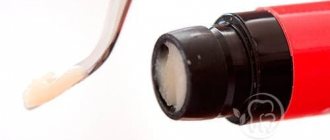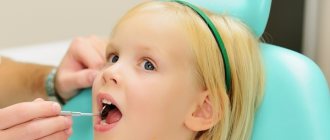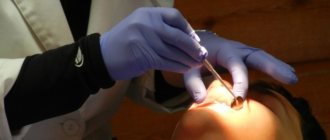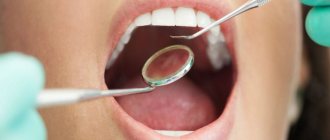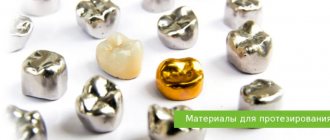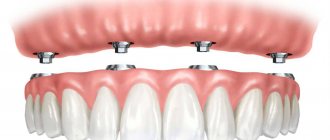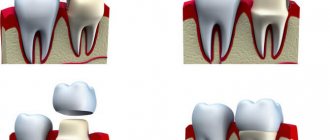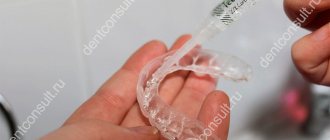A filling in dentistry is a material intended for filling a tooth cavity during the treatment of carious lesions.
In some cases, it is used to correct a defect after injury or other exposure. The material has some viscosity and hardens on its own, or gives the necessary hardness after special processing. Dental filling is used if it is necessary to treat a small surface. For example, in the treatment of caries, pulpitis, periodontitis. The seal is installed after cleaning and treatment with antiseptics.
Its service life directly depends on the selected raw materials. Therefore, it is important to know which filling materials are considered to be of the highest quality and are most often used in dental practice.
When the defect is particularly large, inlays are used for dental reconstruction, which cover large damage and perform various functions.
Bandages
Artificial dentin (aqueous dentin) - zinc oxide (66%) + zinc sulfate (24%) + kaolin (10%). Mixed with water. (Aqueous dentin, oxidentin, timodentin)
Dentin paste - artificial dentin powder + a mixture of two vegetable oils (clove and peach). Available in ready-made form (“Dentin paste”, “TempBond”, “Zinoment”).
Eugenol-free dentin pastes (eugenol is replaced by polymethyl methacrylate). The packaging is usually labeled “NE” (nonevgenol) or “Eugenolfree”. (Cimavit, Coltosol, Simpat, TempBond NE, Tempit, Tempopro, Tempolat).
Photocurable temporary dressings (Clip, PrevisionFill, Fermit, Tempit L/C).
Zinc oxide eugenol cements – zinc oxide + eugenol or clove oil
Requirements for materials for medical pads
Therapeutic pads should:
— have an anti-inflammatory and reparative effect on the pulp;
- have bacteriostatic and bactericidal effects;
— have good adhesion to hard dental tissues;
- be plastic;
- withstand pressure after hardening;
- do not irritate the tooth pulp.
Why is light filling considered the best?
Thanks to the advent of fillings made of light-curing composite, the quality of dental treatment has been raised to the highest level. A special material is used for them. It hardens only under the influence of a special lamp. The material has characteristics that allow a specialist to form the desired shape and adapt it to the required conditions.
The composite has earned excellent reviews in dentistry thanks to:
- long service life;
- aesthetic characteristics, which make it possible to carry out restoration even on the front teeth;
- health safety;
- the ability to choose a shade that will best match the natural color;
- virtually instant hardening.
Today, dentistry uses various composite compounds, which are produced in the USA, Japan, and Europe. One of the best is Enamel filling material, developed by Micerium SpA
But in case of severe destruction, tooth restoration will require more than just filling material. To strengthen the structure, it is necessary to use a pin.
Strengthened glass ionomers
CERMETS – ceramic-metal glass ionomers are created by “alloying” glass ionomer powder and metal or ceramic particles. Used for filling cavities of classes I and II.
Representatives: Chelon Silver, Miracle mix, Ketac Silver, Fuji IX, Ceramcor Silver, Alfa-Silver.
One-component light-curing glass ionomers
They have only one curing mechanism - light ==> no OVR and no chemical bond with dentin and enamel
Representatives: Ionosit, Ionoseal, Cavalite, Ceptocal LC…
What is tooth extension on a pin?
A pin is a small rod whose purpose is to strengthen the entire structure. It is installed in the root canal.
Tooth extension onto a pin may be required if:
- chipped teeth and cracks;
- enamel damage;
- violation of the integrity of the tooth as a result of trauma;
- loss of part of the tooth surface as a result of caries.
The most commonly used pins are:
- anchor - made from high-strength materials, they allow you to restore even the most severe damage. An important condition for their installation is healthy root canals;
- fiberglass - hypoallergenic and safe. Their main advantages are that they are easy to install, not subject to discoloration and corrosion;
- titanium - used when it is necessary to restore large damage.
The design of the pin is selected depending on the degree of destruction, as well as in accordance with the wishes and financial capabilities of the patient.
Nanoionomers
Ketac N 100 is a light-curing glass ionomer restorative material, which is a nanofilled light-curing modified glass ionomer restorative material in paste/paste form.
Indications are the same as for hybrid glass ionomers.
Benefits – improved aesthetics and polishability
Flaws:
— lack of chemical adhesion;
- reduced fluoride release.
Types of materials used for fillings
All filling materials must:
- be resistant to chemical attack - not subject to destruction from exposure to saliva, food, dentinal fluid;
- withstand significant mechanical loads;
- perform the functions of enamel and are not subject to rapid destruction;
- have a tight fit to the walls of the tooth;
- match the appearance of the tooth in such parameters as color, transparency and shape;
- prevent further development of caries;
- do not cause harm to health.
The following groups of materials are used for permanent fillings:
- Metal (amalgams) – contain various metals. Their main advantage is durability. Such a filling can last for several decades. Its disadvantages are visibility, the harmful effects of mercury included in the composition. Today, such fillings are used extremely rarely.
- Cements are used quite often. They have different compositions, on which their characteristics depend.
- Composites are the most popular materials in modern practice. They are divided into chemical and light curing composites. Light-curing material has the best qualities. Its advantages include high strength, ease of use, and excellent aesthetic properties. Therefore, it is used not only for filling, but also for restoring shape.
Compomers
(combine the technology of manufacturing composites and glass ionomers, one-component, light-curing).
Composition: acrylic resins, strontium-fluorine-silicon glass, strontium fluoride, polymerization initiators, stabilizers, polyacrylic acid.
Positive properties: Negative properties:
- biocompatibility - low strength
-chemical adhesion - relative aesthetics
-remineralizing effect
Indications for use:
-for filling baby teeth;
-for filling unloaded cavities of permanent teeth and with poor oral hygiene;
-as insulating gaskets.
Representatives: Dyract, Dyract AR, Dyractflow, F 2000, Compoglass F, Compoglassflow, Hytac, Elan.
Types of fillings
Dental fillings are distinguished by the time of use and the quality of the material. Temporary fillings are installed for a short period; they close the tooth cavity until the next visit to the dentist. Permanent ones are installed for a long period (1-5 years). They are installed only on sanitized surfaces.
Purpose of permanent fillings:
- prevent harmful microorganisms from entering the deep layers of dentin;
- prevent the development of secondary caries;
- help recreate the shape of the tooth.
When using high-quality materials installed in compliance with the necessary standards, the filled tooth will not differ from other units in the dentition.
Definition
At this stage of development and innovation, the field of dentistry regularly uses more than 300 types of consumables, which play an important role in various areas.
Consumables are the means on which the quality of the work performed and the final result depend.
Here we can highlight:
- filling compounds;
- attachments for working with materials (intraoral, mixing);
- dental threads for sutures;
- means to prevent any diseases of teeth and gums;
- means and materials that protect the specialist and the patient from the danger of infection by microorganisms (bacteria, fungi, protozoa, viruses, prions and other pathogenic microbes).
Every year, companies involved in the production of dental consumables are developing rapidly. The demand for dental supplies is only increasing.
That is why the area for the production of such products has decided to provide its partners with comprehensive kits, which include various materials and tools for carrying out certain activities and procedures.
Such complete kits are in demand among specialists due to the significant savings in time for providing dental services and the reduction in their cost.
Reviews
Despite the fact that consumables do not seem so significant, the result of the procedures performed will partly depend on them.
Often, banal savings on the use of certain necessary materials significantly affect the result of treatment or surgical intervention.
If you have ever appreciated the usefulness of dental consumables, share your opinion with readers in the comments to this article.
If you find an error, please select a piece of text and press Ctrl+Enter.
Plastic options - a breakthrough in dentistry
Plastic fillings are characterized by excellent strength and long service life if installed correctly. Plastics are made from the following materials:
- Acrylic acids, which are toxic to the human body. This composition can provoke allergies in the patient. Often pores appear in it, which threatens to increase the risk of secondary caries. These dental fillings quickly darken due to smoking and drinking drinks containing dyes. Acrylic acids negatively affect the pulp and often provoke the occurrence of pulpitis.
- Epoxy resin. Its toxicity is much lower. Fillings of this type are installed on chewing teeth, because they darken over time. Resin is not suitable for restoration of the frontal group due to its fragility.
The cost of plastic fillings is reasonable. They are easy to match to the tooth color because they come in many shades.
The cost of plastic fillings is reasonable. They are easy to match to the tooth color because they come in many shades.
Composite Curable Types
Chemical composites contain an organic matrix (approximately 70%) and inorganic particles (at least 30%). The seal consists of a main part and a catalyst. Its advantages:
- high strength;
- uniform curing;
- inertness to saliva;
- excellent wear resistance.
Composites harden in a matter of seconds, so the doctor’s actions must be as fast as possible. Only a good specialist can deliver them efficiently. In addition to restoration work, the material is also used to fix mobile teeth with periodontitis.
Surgery with osteoplastic material at A-Medic
Osteoplastic operations are recognized as one of the most difficult (from a technical point of view) in the field of dental surgery. To avoid a number of negative consequences after surgery, they should be performed only in trusted clinics. Highly qualified dental specialists at A-Medic have been specializing in these operations for many years. The clinic is equipped with modern instruments, modernized equipment and the necessary lighting, which guarantees a positive result of therapy.
Doctors perform high-quality surgical interventions of any complexity using various osteoplastic materials. The cost of the procedure is significantly lower than in other private clinics in Moscow. You can find out more about the price list on the official website. To make an initial appointment with a dentist, just call the clinic at the numbers provided or leave a request online (indicating your name and contact number).
Type of osteoplasty
Below are the main types of osteoplasty to understand for which surgical interventions a specific type of material is used:
- autotransplantation. This is a procedure that involves moving a tooth from one place to another in order to fill a visually and functionally significant defect. Eighth molars (wisdom teeth) are most often transplanted. As a result of the operation, the bone tissue becomes significantly wider;
- sinus lift. This is a surgical intervention that is performed on the upper jaw in order to increase the length of bone tissue in case of its deficiency.
It is possible to increase the volume of bone tissue through the use of materials of synthetic origin. Barrier membranes are used to fix transplanted bone tissue or to protect a person’s bone tissue after a molar or premolar has been removed. Allografts are used to restore bone tissue. The most common are autografts.
For therapy
Every patient who devotes a sufficient amount of time to oral health is familiar with the therapeutic section of dentistry.
It is this area that deals with the treatment of dental units, periodontal tissues, gums, jaw bones, enamel, dentin and nerve bundles, as well as associated pathological, carious and inflammatory processes.
In addition, therapeutic dentistry performs restoration of broken fragments of a dental unit and installation of fillings.
For all of the above purposes, specialists use various consumables.
Adhesives and Bondings
These products significantly increase the adhesion of filling agents to the bone tissues of the tooth. They have the form of a gel and are used for acid etching of tooth tissue.
Adhesive systems from the 1st to the 3rd generation are inexpensive, however, the procedure using them may take longer.
Therefore, dentists prefer more innovative materials that contain etching elements.
The most popular products in this group are:
- PRIMA 2000. 5th generation adhesive from the Israeli company JM Laboratories - 2 ml bottle 800-900 rubles.
- UNIFIL BOND Primer. Adhesive system from the Japanese concern GC - 6 ml bottle 5000-5500 rubles.
- Master-Dent. Etching gel from the brand Dentonics Inc (USA) - syringe with a volume of 12 g, 700-800 rubles.
Find out what bondings are and their purpose in dentistry from the video.
Padding materials
Such materials are used to cover the pulp. They are made in the form of a polymer gasket, which includes slaked lime (fluff), UDMA and transparent cements (GIC).
The following representatives of cushioning materials have gained popularity in this area:
- Pad. It is made on the basis of calcium hydroxide in the form of a paste-like mass and is represented by the German brand VOCO - base + catalyst 1000-1100 rubles.
- Calcisol C. Calcium hydroxide generating pad from the domestic manufacturer Latus - syringe 1 g 110-120 rubles.
- CALCI-JEN. X-ray contrast material with calcium hydroxide. The drug is produced by JENDENTAL (USA) - 2 ml syringe with nozzles 350-450 rubles.
Endodontic
Consumables in this group are used to unfill a tooth, clean a cavity, or expand a canal.
Here you can highlight the following tools:
- Antibacterial solution based on chlorhexidine . Made in the USA by the Ultradent trademark - 30 ml syringe 2200-2400 rubles.
- Canal+. Gel for mechanical treatment and expansion of root canals. Presented on the dental market by Septodont (France) - 5 g syringe. + tips 1500-1800 rubles.
- Largal Ultra. Chelate compound for chemical expansion of channels. The manufacturer is Septodont (France) - 13 ml bottle 900-1100 rubles.
- Solvadent liquid No. 2 from the manufacturer Vladmiva. This product is used for desobturation of root canals from filling materials - 10 ml bottle 200-250 rubles.
Treatment tactics for cervical caries and possible consequences of ignoring therapy. In this publication we will look at the causes of tartar.
Follow the link https://dr-zubov.ru/lechenie/zuby/vidy-mestnoj-anestezii-v-stomatologii-na-lyuboj-vozrast-i-individualnye-osobennosti-organizma.html if you are interested in what local anesthesia is used in dentistry during pregnancy.
Anti-inflammatory
These drugs are used to achieve therapeutic and prophylactic effects.
The work of the drugs can be aimed both at the treatment of periodontal diseases and at providing a pronounced antiseptic and resorbing effect.
Popular drugs are:
- Iodotin from Tehno Dent. It is a non-hardening paste for the treatment of granulating periodontitis - 25 g glass jar. 160-170 rubles.
- Iodex paste from the manufacturer Omega. The drug was created for the treatment of pulpitis and periodontitis - 15 g jar. 350-380 rubles.
- Abscess Remedy Paste from Product Dentaires SA Vevey. The paste is designed for antiseptic treatment of root canals in the treatment of chronic ulcerative pulpitis, pulp necrosis, as well as for temporary filling and medicinal treatment.
Sealants
Sealants are used in dentistry to apply an insulating film on fissures and grooves formed on the surface of the enamel due to the carious process.
Among the popular products are the following sealants:
- UltraSeal XT plus. Sealing agent for treating pits and fissures. Presented on the dental market by Ultradent (USA) - syringe 1.2 ml 1000-1100 rubles.
- Fissurit FX. Highly filled sealant containing fluorine. The drug is intended for invasive sealing. The manufacturer is Voco Corporation (Germany) - syringe 2.5 g 1100-1200 rubles.
- Fissulight LC from the domestic manufacturer Vladmiva. The drug is intended for sealing anatomical pits and fissures - 1 ml syringe 650-800 rubles.
Filling materials
In dentistry, a filling is considered a material that is used to fill carious cavities, holes, or when a piece of a tooth is lost due to injury. The role of the filling is to isolate the sensitive tissues of the dental unit from microbes and irritants.
For these purposes, dentists use both classical materials and hybrid products, the advantage of which is the curing system. As an example, let’s look at the cost of several options for popular filling materials:
- Charisma Heraeus Kulzer from the German company Harius Kulzer. The base of the composite consists of microglass and has high light-curing properties - 4 g syringe 750-850 rubles.
- Compolux from the Septodont brand (France) . The product is a chemically cured composite material with a bonding system. The kit includes a catalyst, base, etching gel - 1300-1400 rubles.
- Dent Light from the Vladmiva brand. The composite is intended for restoration of dental cavities - syringe 4.5 g 350-400 rubles.
Watch the video about the production and use of composite materials for fillings.
Polishing agents
Thanks to polishing and grinding of teeth, the enamel whitens, dental tissues are strengthened, the surface becomes smooth, and bad breath is eliminated.
Often, specialists use polishing to smooth out the boundaries between the dental tissue and the filling. During the procedure, the specialist uses polishing pastes with different abrasiveness levels.
The cost of these products depends on the quality and manufacturer. Among the common materials the leaders are:
- Polident No. 4 from the Vladmiva trademark (Russia). The material is intended for polishing the filling composition - 6 g syringe 120-130 rubles.
- Professional tooth polishing paste presented by the Swiss manufacturer Dr. Wild & Co - 400 ml jar 3600-4000 rubles.
- Proklin z. The polishing paste is manufactured by the Latus trademark (Ukraine). The package contains 2 syringes of 8 g each. The product is considered a budget option with excellent quality indicators - 110-120 rubles.
Preventive
Consumables in this group are used by dentists to carry out preventive measures.
The most commonly used popular dental products are:
- Desensital N (Ukraine). In dentistry it is used to prevent the occurrence of hypersensitivity of hard dental tissues after restoration measures - a bottle of 10 ml 200-250 rubles.
- Arde after care (Germany). The material is used to prevent the occurrence of enamel sensitivity after the whitening procedure - 2 ml syringe 350-400 rubles.
- Belak-F (Russia). The product is a one-component fluoridating varnish, which serves to prevent caries - 25 ml bottle 250-280 rubles.
Indicators
In dental practice, specialists often use indicators, or rather caries markers, which can identify diseases and indicate the boundaries of tissue damage.
In simple terms, the indicator paints the affected area in a bright color, which makes it easy to identify the degree of destruction of the bone tissue of the tooth.
Popular indicators include:
- Sable Seek. Caries indicator from the Ultradent brand (USA) - syringe 1.2 ml 350 rubles.
- Caries Marker. Caries marker from the Voco brand (Germany) - 1 ml bottle 550 rubles.
- Caries indicator in gel form. The product is presented by the manufacturer Omega (Russia). The set contains 2 syringes of 2.5 ml - 550-650 rubles.
For prosthetics
Materials used for various procedures in dental clinics are divided into several types.
Consumables are classified into various areas in the field of dentistry, for example, materials for prosthetics, surgical, orthodontic and other areas.
This separation of types allows dental clinics to quickly make purchases and determine the necessary consumables that are acceptable in their properties and cost.
The group of prosthetics includes means that make it possible to maximize the quality of the manipulations performed to solve problems associated with the dentofacial apparatus with the subsequent installation of orthopedic systems.
To determine the bite
To register a bite, dentists use impression materials from different manufacturers, the most popular of which are the following:
- O-Bite, presented by a German company. This brand of impression material is considered an impression material with 12 mixing tips per package.
The advantages include high strength and hardness of the material, minimal resistance to bite, precision in the transfer of contours, registration of both dentitions in one procedure. In addition, the mass hardens quickly and has a pleasant citrus aroma. Cost: 3800-4000 rubles. - Greenbite apple is produced in Germany by the company. The basis of the registration material is A-silicone, which has a thin viscosity and is characterized by medium fluidity and thixotropy.
The mass is not able to penetrate into the interdental space and is easily removed from the oral cavity. Polymerization occurs in 1 minute, which primarily distinguishes the material from its analogues. The set includes 12 pieces of mixing cannulas and contour tips. Price: 2500 rubles. - Elite HD+ Light Body Normal from the Italian corporation Zhermack . This product is considered a Class A hydrocompatible dental silicone impression material.
Has a runny consistency. Includes 12 mixing tips. The advantages of the mass include high biocompatibility, maximum precision in reproducing parts, increased dimensional stability, tensile strength, the ability to form a model after disinfection, and a long warranty period. Cost: 1300 rubles.
To form a dental stump
As a rule, clinics use both standard radiopaque unfilled composites with remineralizing properties and nanocomposites characterized by double and triple curing.
The following representatives of this group are widely used:
- Bis-Core. Dual-curing composite from the American manufacturer Bisco. Today it is recognized as the most durable material. Dentists prefer the material for its highest conversion rate and unprecedented strength. Price: 3200-3500 rubles.
- Jen LC-Core. The material is made in the USA and belongs to the category of highly filled, light-cured composite materials. It is most often used to restore the coronal part of teeth and build up a stump. The product has a blue color or a dentin tint. Cost: 700-800 rubles.
- RESIGLASS F. The material is manufactured in Brazil by the leading company Biodinamica.
It is considered a light-curing glass ionomer core material. This cement is capable of releasing fluoride, which is very important in modern dentistry. The advantages include aesthetic, mechanical features and anti-caries effects. In orthopedics it is used as a cushioning material when restoring a dental stump. Price: 3500-3700 rubles.
What is deep caries and what does it look like on an x-ray? We will discuss here the causes of an abscess after wisdom tooth removal.
At this address https://dr-zubov.ru/lechenie/zuby/kompyuternaya-tomografiya-sovremennyj-podxod-k-sverxtochnoj-diagnostike.html we’ll talk about cone-beam computed tomography of teeth.
For making temporary crowns
To perform these tasks, specialists more often use acrylic composites, however, as a good replacement, you can resort to using plastic masses or one-step cements.
As an example, consider several materials from well-known manufacturers:
- Q-Crown. The composite was created by JM Laboratories in Israel and is intended for the manufacture of temporary orthopedic structures. The material is strong in compression and bending, does not increase the internal temperature during polymerization, is elastic and easy to polish. Price: 3500 rubles.
- SUCCESS CD. The composite material is presented by a German company. It is characterized by high strength and withstand strong functional loads. It polishes well, retains its original shade, and cures quickly. Cost: 3500-4000 rubles.
- TempSpan C&B Material. This composite system for the rapid production of orthopedic replacements was manufactured by Pentron in the USA.
The possibility of double curing provides the material with unique technical characteristics, and thanks to the matrix of the substance, the finished product can easily be adjusted or refined with a fluid. Price 4000-4700 rubles.
Pins
Pins are usually called rods that a specialist uses to strengthen a damaged crown.
The design is used by a specialist when it becomes impossible to solve the problem in any other way, that is, when the crown cannot be restored without extension to the pin.
Pins are made from various materials, which differ in technical characteristics and quality.
Let's consider several popular models that can be purchased in online stores:
- A set of Unimetric titanium posts presented by the Swiss company Dentsply Maillefer. The set includes 145 pins with different crown heights, as well as penetration, calibration drills and cross-shaped keys. The design lasts about 3-4 years, and the quality of installation depends entirely on the qualifications of the specialist. Cost: 10,000–12,000 rubles.
- Set of gold plated anchor pins. Manufactured by various brands. Sold 12 pieces per pack. High quality brass products are widely used in dentistry. The thickness of the gold coating is 3 microns. Price for 1 piece. size S1 is 150-180 rubles.
- Dental Screw Post. These gold-plated anchor pins were released onto the dental market by the Swiss company Nordin. Each pin in the set is equipped with a shank, which makes screwing much easier without putting pressure on the dentin. The cost ranges from 350-800 rubles.
